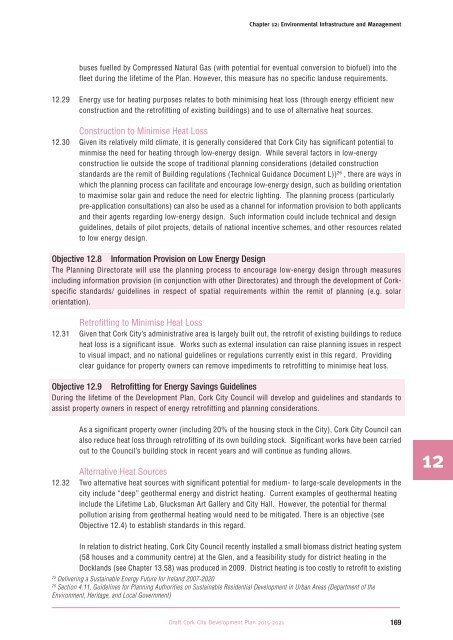Volume 1 Written Statement
Volume 1 Written Statement
Volume 1 Written Statement
You also want an ePaper? Increase the reach of your titles
YUMPU automatically turns print PDFs into web optimized ePapers that Google loves.
Chapter 12: Environmental Infrastructure and Management<br />
x<br />
buses fuelled by Compressed Natural Gas (with potential for eventual conversion to biofuel) into the<br />
fleet during the lifetime of the Plan. However, this measure has no specific landuse requirements.<br />
12.29 Energy use for heating purposes relates to both minimising heat loss (through energy efficient new<br />
construction and the retrofitting of existing buildings) and to use of alternative heat sources.<br />
Construction to Minimise Heat Loss<br />
12.30 Given its relatively mild climate, it is generally considered that Cork City has significant potential to<br />
minmise the need for heating through low-energy design. While several factors in low-energy<br />
construction lie outside the scope of traditional planning considerations (detailed construction<br />
standards are the remit of Building regulations (Technical Guidance Document L)) 26 , there are ways in<br />
which the planning process can facilitate and encourage low-energy design, such as building orientation<br />
to maximise solar gain and reduce the need for electric lighting. The planning process (particularly<br />
pre-application consultations) can also be used as a channel for information provision to both applicants<br />
and their agents regarding low-energy design. Such information could include technical and design<br />
guidelines, details of pilot projects, details of national incentive schemes, and other resources related<br />
to low energy design.<br />
Objective 12.8 Information Provision on Low Energy Design<br />
The Planning Directorate will use the planning process to encourage low-energy design through measures<br />
including information provision (in conjunction with other Directorates) and through the development of Corkspecific<br />
standards/ guidelines in respect of spatial requirements within the remit of planning (e.g. solar<br />
orientation).<br />
Retrofitting to Minimise Heat Loss<br />
12.31 Given that Cork City’s administrative area is largely built out, the retrofit of existing buildings to reduce<br />
heat loss is a significant issue. Works such as external insulation can raise planning issues in respect<br />
to visual impact, and no national guidelines or regulations currently exist in this regard. Providing<br />
clear guidance for property owners can remove impediments to retrofitting to minimise heat loss.<br />
Objective 12.9 Retrofitting for Energy Savings Guidelines<br />
During the lifetime of the Development Plan, Cork City Council will develop and guidelines and standards to<br />
assist property owners in respect of energy retrofitting and planning considerations.<br />
As a significant property owner (including 20% of the housing stock in the City), Cork City Council can<br />
also reduce heat loss through retrofitting of its own building stock. Significant works have been carried<br />
out to the Council’s building stock in recent years and will continue as funding allows.<br />
Alternative Heat Sources<br />
12.32 Two alternative heat sources with significant potential for medium- to large-scale developments in the<br />
city include “deep” geothermal energy and district heating. Current examples of geothermal heating<br />
include the Lifetime Lab, Glucksman Art Gallery and City Hall. However, the potential for thermal<br />
pollution arising from geothermal heating would need to be mitigated. There is an objective (see<br />
Objective 12.4) to establish standards in this regard.<br />
12<br />
In relation to district heating, Cork City Council recently installed a small biomass district heating system<br />
(58 houses and a community centre) at the Glen, and a feasibility study for district heating in the<br />
Docklands (see Chapter 13.58) was produced in 2009. District heating is too costly to retrofit to existing<br />
25<br />
Delivering a Sustainable Energy Future for Ireland 2007-2020<br />
26<br />
Section 4.11, Guidelines for Planning Authorities on Sustainable Residential Development in Urban Areas (Department of the<br />
Environment, Heritage, and Local Government)<br />
Draft Cork City Development Plan 2015-2021<br />
169


